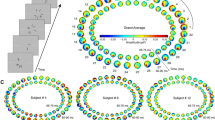Abstract
THE average evoked response in man to stimulation of the visual field with a reversing checkerboard pattern and recorded from the scalp over the occipital region has a waveform which is consistent both within and between subjects. The most characteristic feature for full-field stimulation is a major positive component at about 100 ms which is recorded maximally 5 cm above the inion in the midline and is distributed fairly symmetrically over both sides of the head (Fig. 1). The pathways from the retina to the visual cortex undergo partial decussation in the chiasma, so that information presented to the left half of the visual field passes to the right hemisphere, whereas the left hemisphere receives signals from the right half of the visual field. Consequently, it might be predicted that stimulation of one half field will produce an evoked response which is maximal over the contralateral hemisphere. The data presented here show that, contrary to this prediction, the maximal response occurs at the scalp electrodes situated over the hemisphere ipsilateral to the field stimulated.
Similar content being viewed by others
References
Halliday, A. M., Halliday, Elise, Kriss, A., McDonald, W. I., and Mushin, Joan, Brain, 99, 357–374 (1976).
Author information
Authors and Affiliations
Rights and permissions
About this article
Cite this article
BARRETT, G., BLUMHARDT, L., HALLIDAY, A. et al. A paradox in the lateralisation of the visual evoked response. Nature 261, 253–255 (1976). https://doi.org/10.1038/261253a0
Received:
Accepted:
Issue Date:
DOI: https://doi.org/10.1038/261253a0
- Springer Nature Limited
This article is cited by
-
Optical coherence tomography and visual evoked potentials in evaluation of optic chiasm decompression
Scientific Reports (2022)
-
Effect of sustained selective attention on steady-state visual evoked potentials
Experimental Brain Research (2022)
-
Clinical electrophysiology of the optic nerve and retinal ganglion cells
Eye (2021)
-
What can visual electrophysiology tell about possible visual-field defects in paediatric patients
Eye (2021)
-
Case report: Unilateral optic nerve aplasia and developmental hemi-chiasmal dysplasia with VEP misrouting
Documenta Ophthalmologica (2021)





